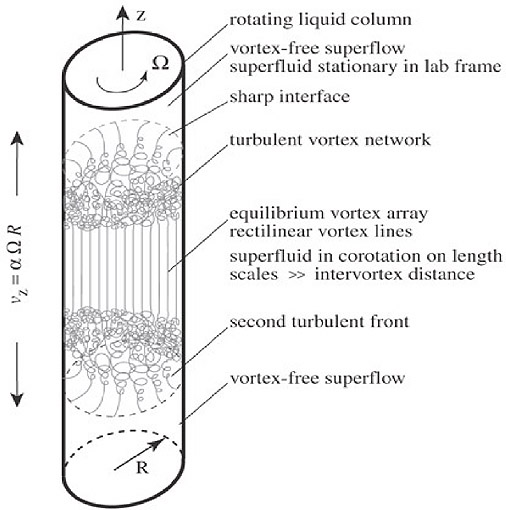
Topological objects in coherent quantum systems
S. Boldarev, B. Eltsov, A. Finne, M. Kujala, A. Kulvik, and M. Krusius
Visitors: R. Blaauwgeers, G. Eska, A. Gordeev, Z. Janú, and L. Skrbek.
This experimental research project is concerned with coherent quantum systems. The most important examples of such condensed-matter systems are superconducting metals, superfluid helium liquids, and gaseous Bose-Einstein condensed alkali atom clouds. They obey the laws of quantum mechanics in macroscopic scale. They are comparatively well understood since the best theories of condensed matter physics can be used to describe them.
The state of these systems is described with an order-parameter field, which is similar to a Schrödinger wave function of atomic physics and contains the spatial and temporal information about the coherent condensate. The order parameter field may contain defects, structures which are topologically stable owing to the continuity requirement of the coherent condensate. In practice this means that such structures cannot have loose ends in the bulk system. The most important example of such topologically stable defects is a quantized vortex line.
The largest variety of defects of different dimensionality, topology, and structure exists in the helium-3 superfluids. These Fermi systems are experimentally clean, structurally simple, and theoretically well understood. All their complexity is contained in the symmetry and structure of the multi-component order parameter field. Owing to their almost ideal properties these systems are well suited as laboratory analogue models in which various quantum mechanical phenomena can be studied under direct external control from the laboratory. This is the centerpiece of our investigations: The design of accurately engineered experiments which reveal the detailed response of these quantum mechanical systems.
Superfluid Turbulence: Recent research has been concerned with turbulent hydrodynamics of superfluids. In the study of turbulence, superfluids have the advantage that their vortices are well-defined structures, quite unlike the vortices of classical viscous fluids. It is hoped that by studying turbulent superflow, i.e. the chaotic motions in a disordered tangle of quantized vortex lines, more will be understood about the fundamental laws that govern turbulence in general.
Our experiment is designed to study the evolution and decay of a turbulent vortex network in a long rotating column. This is accomplished by first setting the column in vortex-free rotation at constant velocity. Here the normal excitations are corotating with the cylindrical container walls, while the superfluid fraction behaves differently: It is decoupled from the rotation and remains therefore stationary in the laboratory frame. In the rotating coordinate frame, which is usually the working frame in rotating hydrodynamics, the superfluid fraction flows at great velocity.
The next step is to inject a few small vortex loops in the rapid superflow. Different injection methods can be used. With nuclear magnetic resonance measurement, which is performed non-invasively from the outside, we can then follow the evolution of the injected loops in the superfluid stream. If the damping of vortices is sufficiently low, which requires low temperatures, the loops develop first into a rotating vortex tangle, which later decays into an array composed of rectilinear vortex lines. This is the stable equilibrium configuration of quantized vorticity in rotation. The structure in which the vorticity expands into the vortex-free superflow is sketched in the adjacent figure. The measurement allows us to analyze the rate at which the turbulent front moves along the column in both directions, how the initial tangled vortex density builds up at a fixed location in the column, how the tangle polarizes and the large-scale superflow is removed, and finally how the tangle decays into rectilinear lines.
In the investigation of superfluid turbulence the advantages of such a measurement are the following:

Fig. 1. Expansion of quantized vorticity in a rotating superfluid column. Initially the column rotates in the vortex-free state. When vortex loops are injected they develop into a superfluid tangle which then expands in the column. The velocity of the two turbulent fronts propagates at a velocity which is controlled by the dissipative mutual friction.
Many unsolved questions shroud superfluid turbulence, especially its dissipation mechanisms. For instance, what happens in the zero-temperature limit where the density of normal excitations approaches exponentially zero and the superfluid fraction should be totally decoupled from the laboratory. Nevertheless, we now know from our measurements that quantized vortices are both formed at the lowest temperatures and that their tangled state decays more and more rapidly with decreasing temperature. In contrast a superfluid with nodes in its energy gap, like the A phase of superfluid helium-3, is practically always in a state where vortex motion is highly highly damped and superfluid turbulence does not appear possible even in the zero temperature limit. How are these facts reconciled and what are the explanations for such unusual behaviour? These are the burning questions in our current work.